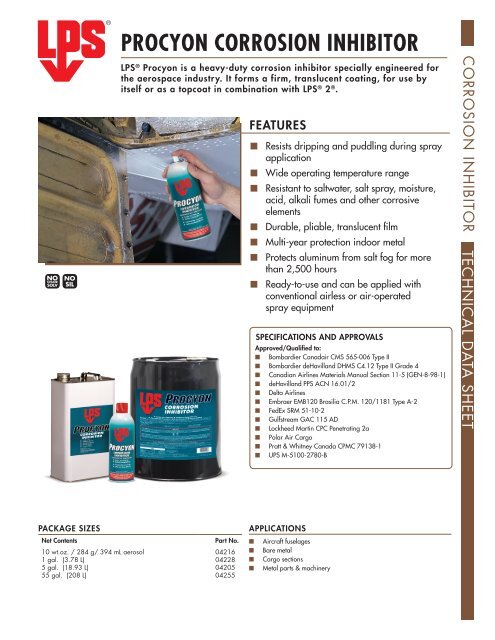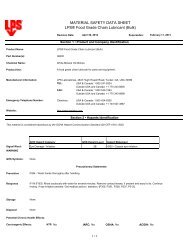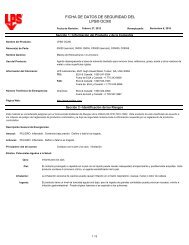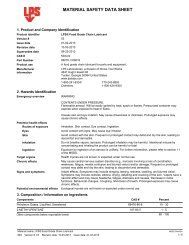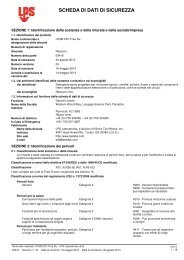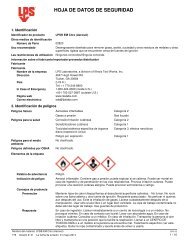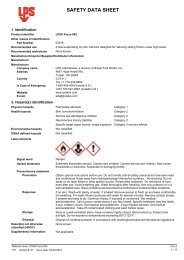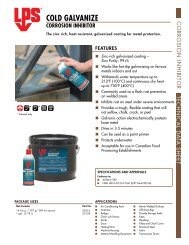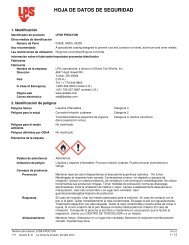PROCYON CORROSION INHIBITOR - LPS Laboratories
PROCYON CORROSION INHIBITOR - LPS Laboratories
PROCYON CORROSION INHIBITOR - LPS Laboratories
You also want an ePaper? Increase the reach of your titles
YUMPU automatically turns print PDFs into web optimized ePapers that Google loves.
<strong>PROCYON</strong> <strong>CORROSION</strong> <strong>INHIBITOR</strong><br />
<strong>LPS</strong> ® Procyon is a heavy-duty corrosion inhibitor specially engineered for<br />
the aerospace industry. It forms a firm, translucent coating, for use by<br />
itself or as a topcoat in combination with <strong>LPS</strong> ® 2 ® .<br />
FEATURES<br />
■■<br />
■■<br />
■■<br />
■■<br />
■■<br />
■■<br />
■■<br />
Resists dripping and puddling during spray<br />
application<br />
Wide operating temperature range<br />
Resistant to saltwater, salt spray, moisture,<br />
acid, alkali fumes and other corrosive<br />
elements<br />
Durable, pliable, translucent film<br />
Multi-year protection indoor metal<br />
Protects aluminum from salt fog for more<br />
than 2,500 hours<br />
Ready-to-use and can be applied with<br />
conventional airless or air-operated<br />
spray equipment<br />
SPECIFICATIONS AND APPROVALS<br />
Approved/Qualified to:<br />
■■<br />
Bombardier Canadair CMS 565-006 Type II<br />
■■<br />
Bombardier deHavilland DHMS C4.12 Type II Grade 4<br />
■■<br />
Canadian Airlines Materials Manual Section 11-5 (GEN-8-98-1)<br />
■■<br />
deHavilland PPS ACN 16.01/2<br />
■■<br />
Delta Airlines<br />
■■<br />
Embraer EMB120 Brasilia C.P.M. 120/1181 Type A-2<br />
■■<br />
FedEx SRM 51-10-2<br />
■■<br />
Gulfstream GAC 115 AD<br />
■■<br />
Lockheed Martin CPC Penetrating 2a<br />
■■<br />
Polar Air Cargo<br />
■■<br />
Pratt & Whitney Canada CPMC 79138-1<br />
■■<br />
UPS M-5100-2780-B<br />
<strong>CORROSION</strong> <strong>INHIBITOR</strong> TECHNICAL DATA SHEET<br />
PACKAGE SIZES<br />
Net Contents<br />
10 wt.oz. / 284 g/ 394 mL aerosol<br />
1 gal. (3.78 L)<br />
5 gal. (18.93 L)<br />
55 gal. (208 L)<br />
Part No.<br />
04216<br />
04228<br />
04205<br />
04255<br />
APPLICATIONS<br />
■■<br />
Aircraft fuselages<br />
■■<br />
Bare metal<br />
■■<br />
Cargo sections<br />
■■<br />
Metal parts & machinery
<strong>PROCYON</strong> <strong>CORROSION</strong> <strong>INHIBITOR</strong><br />
PROPERTIES<br />
Appearance/physical state Viscous Liquid Color Medium to dark brown<br />
Odor Cherry Vapor pressure 2.6 mmHg at 20°C<br />
Boiling/Condensation point °F(°C) 320°F (160°C) Flash point °F(°C) 107°F - 113°F (42°C - 45°C)<br />
Specific gravity (water=1)<br />
Aerosol: 0.76-0.78 @ 20°C<br />
Bulk: 0.88-0.90 @20°C<br />
Flash point method<br />
Tag-Closed Cup<br />
Solubility in water Insoluble in cold water Auto ignition Temperature °F(°C) >446°F (230°C)<br />
VOC<br />
Aerosol: 51.1% (392 g/L) per U.S.<br />
State & Federal Consumer<br />
Product Regulations<br />
Bulk: 52.2% (463 g/L) per U.S. State<br />
& Federal Consumer Product<br />
Regulations<br />
Pour Point °F(°C)<br />
Not Established<br />
(Best if used above 40°F (4°C))<br />
Flammable limits (estimated)<br />
Aerosol: 0.6%<br />
Bulk: 0.6% LOWER<br />
Aerosol: 12.8%<br />
Viscosity 83 - 288 cSt @ 20°C<br />
Bulk: 6% UPPER<br />
Volatiles<br />
Aerosol: 74-77%<br />
Bulk: 52.2%<br />
Coverage per gallon<br />
267 ft2/gallon @ 6 wet mils<br />
Wet Film Thickness 4 – 8 mils Dry Film Thickness 2 – 4 mils<br />
Humidity Cabinet Test<br />
(ASTM D 1748)<br />
Not Established<br />
Salt Spray Cabinet Test<br />
(ASTM D 177)<br />
Propellant (Aerosol) Hydrocarbon Corrosion Protection<br />
Dry Time to Handle 3 – 5 hours Full Cure 24 hours<br />
2500+ hours on Aluminum<br />
Indoors: 36 months<br />
Outdoors: Not recommended<br />
Dielectric Strength Not Established HMIS 1996 Aerosol: 1, 3, 0 Bulk: 1, 2, 0<br />
Temperature Range °F(°C) –40°F – 200°F (– 40°C – 93°C) HMIS III Aerosol: 1, 4, 2 Bulk: 1, 2, 0<br />
Spray Pattern<br />
Cone shaped mist<br />
HANDLING<br />
DO NOT spray into or around ignition sources. Avoid contact with<br />
eyes, skin and clothing. Wear appropriate protective equipment during<br />
handling. Keep container closed. Do not breathe vapors or mists. Use<br />
only with adequate ventilation. Wash hands and contaminated clothing<br />
thoroughly after handling.<br />
STORAGE<br />
Keep container in a cool, well-ventilated area. Avoid all sources of ignition<br />
(spark or flame). Store below 120°F (49°C).<br />
Store aerosols as Level 3 Aerosol (NFPA 30B). Store all materials in dry,<br />
well-ventilated area. Avoid breathing vapors.<br />
DIRECTIONS<br />
Aerosol: Shake well before using. Hold can 8 to 12 inches away from surface to be sprayed. Apply a light, even coat. For best results use at room<br />
temperature, 70°F (21°C). Attach extension tube for difficult to reach areas. Wipe off any excess. If an additional coat is desired, allow a minimum of<br />
3 hours cure before applying second coat. Use only in well ventilated area. Avoid all sources of ignition<br />
(spark or flame).<br />
Bulk: Stir container with mechanical stirrer to ensure product consistency. Brush, roll, or spray light even coat onto metal surface using paint sprayer<br />
or airless spray equipment. For best results use at room temperature 70°F (21°C). Wipe off any excess. If an additional coat is desired, allow a minimum<br />
of 3 hours cure before applying second coat. Use only in well ventilated area. Avoid all sources of ignition<br />
(spark or flame).<br />
Always use proper personal protective equipment as listed on MSDS.<br />
ADDITIONAL INFORMATION<br />
Removal Information: Removal of Procyon is best accomplished using a moderate strength solvent such as <strong>LPS</strong> ® PreSolve ® or <strong>LPS</strong> ® A-151 (mineral spirits<br />
will suffice but may require more time to remove). Saturate the coating with the solvent using an aerosol or by brushing or rolling the solvent onto the corrosion<br />
inhibitor surface. Allow the degreaser to dwell on the surface for several minutes until the coating softens. Agitation with a stiff brush may increase effectiveness.<br />
Wipe and/or scrape the softened coating to remove. Dispose of waste according to local and federal regulations.<br />
MATERIAL SAFETY DATA SHEETS AVAILABLE UPON REQUEST OR VISIT OUR WEB SITE : WWW.<strong>LPS</strong>LABS.COM<br />
<strong>LPS</strong> ® <strong>Laboratories</strong> • An Illinois Tool Works Company<br />
4647 Hugh Howell Road • Tucker, GA 30084 • TEL: (800) 241-8334 or (770) 243-8800 • FAX: (800) 543-1563 or (770) 243-8899<br />
Internet Web Site: www.lpslabs.com<br />
©2014 <strong>LPS</strong> ® <strong>Laboratories</strong> • <strong>LPS</strong> ® , <strong>LPS</strong> 2 ® , and PreSolve ® are registered trademarks of Illinois Tool Works • Printed in U.S.A. • All Rights Reserved • Form #2117 • Rev. 11/2014


